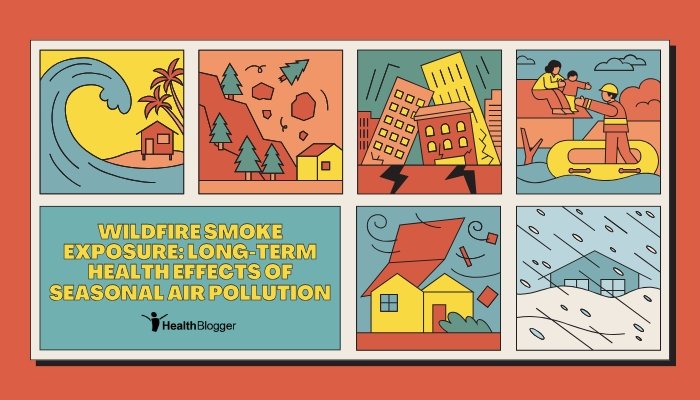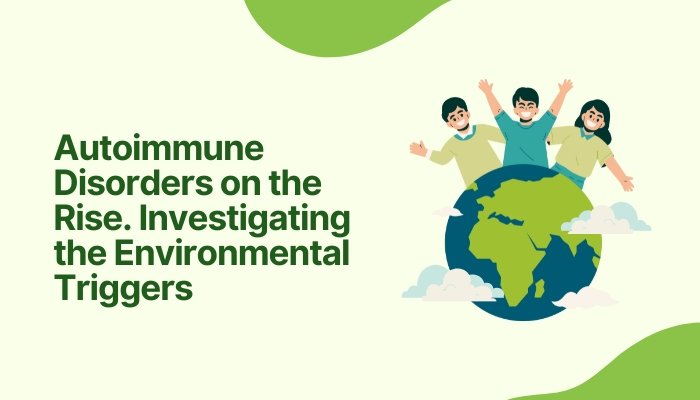As megafires become more frequent and intense, seasonal wildfire smoke has evolved into a significant health concern. In many regions, millions of people now experience days—or even weeks—of severe smoke exposure annually.

While the immediate effects on respiratory health are well-known (e.g., coughing, throat irritation, wheezing), emerging research underscores long-term consequences, including heightened risks of asthma, cardiovascular disease, and elevated mortality linked to inhaling fine particulate matter (PM2.5).
This article explores what wildfire smoke contains, how repeated exposure affects different organ systems, and the pivotal role of public health awareness in adapting to these new challenges.
Introduction
Droughts, higher temperatures, and changing land management practices have led to larger and more frequent wildfires worldwide. While these events have always been dangerous, the risk has shifted beyond the fire line itself, due to massive smoke plumes traveling hundreds or thousands of miles. This smoke reduces air quality, sometimes for weeks, and millions of people inhale it each year.
In addition to the typical acute irritations—watering eyes, scratchy throats, and breathing difficulties—scientists are now concerned about chronic health issues that develop from repeated or cumulative smoke exposure over several wildfire seasons. Greater awareness of how wildfire smoke affects respiratory, cardiovascular, and possibly other systems is crucial for individual decisions (e.g., whether to evacuate or wear masks) and community-level strategies (e.g., air quality alerts, building filtration systems).
What’s in Wildfire Smoke?
Composition of Smoke
Wildfire smoke is a complex mixture of:
- Particulate Matter (PM): Microscopic solids or droplets, including PM10 and the more dangerous PM2.5.
- Gases: Carbon monoxide, nitrogen oxides, volatile organic compounds (VOCs).
- Toxic Substances: Depending on the materials burning (houses, plastics, treated lumber), smoke may contain heavy metals or hazardous chemicals.
PM2.5 Dominance
PM2.5 particles, measuring 2.5 micrometers or smaller, can penetrate deep into the lungs, even entering the bloodstream. They’re widely linked to inflammation and multiple health hazards.
Immediate and Short-Term Health Impacts
- Respiratory Symptoms: Irritation of eyes, nose, throat, plus coughing, wheezing, shortness of breath.
- Worsened Chronic Conditions: People with asthma, COPD, or heart disease may experience exacerbations.
- Fatigue and Dizziness: High pollutant levels can reduce oxygen uptake, causing general malaise.
Local officials often advise sensitive groups (kids, seniors, pregnant women) to stay indoors or use high-efficiency masks (N95 or better) during periods of intense smoke.
Long-Term Exposure Concerns
Asthma and Chronic Lung Disease
- Repeated smoke inhalation episodes may aggravate or contribute to new-onset asthma, especially in children.
- Chronic obstructive pulmonary disease (COPD) progression could accelerate from recurrent inflammatory insults.
Cardiovascular Risks
- PM2.5 has been strongly associated with elevated risk of heart attacks and strokes through systemic inflammation and endothelial dysfunction.
- Prolonged smoke seasons can amplify the burden on circulatory health for entire populations, resulting in higher hospitalization rates.
Mortality Risk
Studies correlate rising PM2.5 from wildfires with increased death rates, primarily among older adults or those with compromised health. Even moderate smoke exposure, if consistent over multiple years, can exert a cumulative toll.
Potential Neurological or Reproductive Effects
Some research hypothesizes that repeated exposure to wildfire pollutants could affect the brain or fetal development. However, data here remain limited, highlighting the need for deeper investigation.
PM2.5: The Key Culprit
Why PM2.5 is Hazardous
- Deep Lung Penetration: These tiny particles evade many of the lungs’ natural defense mechanisms.
- Systemic Inflammation: Once in the bloodstream, PM2.5 can promote oxidative stress and organ-wide inflammatory responses.
- Possible Long-Term Tissue Damage: Repeated infiltration can cause progressive changes to blood vessels, lung tissue, and immune function.
Measuring Air Quality
Tools like the Air Quality Index (AQI) break down pollutant concentrations into color-coded categories. Wildfire episodes can push AQI into unhealthy or hazardous zones, especially for PM2.5 levels.
At-Risk Populations
- Children: Their developing lungs are more susceptible to pollutants. Kids also breathe faster, inhaling more smoke relative to body size.
- Elderly: Age-related decline in cardiopulmonary reserves makes them sensitive to inflammatory stress from smoke.
- Pregnant Women: Potential impacts on fetal growth and preterm birth risk, as seen with other air pollution.
- Individuals with Chronic Conditions: Those with asthma, COPD, heart disease, or diabetes face exacerbated health threats.
Future Research and Public Health Implications
Ongoing Studies
Scientists are intensively tracking:
- Cumulative Smoke Exposure: Mapping how repeated episodes across multiple fire seasons influences disease incidence and mortality.
- Indoor vs. Outdoor: Evaluating the efficacy of air filtration systems in preventing infiltration of fine particles at home or workplaces.
- Genetic Susceptibility: Considering if certain genotypes respond more severely to pollutant stressors.
Policy and Infrastructure
- Evacuation Protocols: As fires intensify, local health agencies weigh the cost-benefit of community evacuations.
- Urban Planning: Designing “clean air shelters” or communal buildings with advanced filtration for at-risk populations.
- Climate Mitigation: Addressing the underlying rise in megafires, partly driven by climate change, remains crucial for tackling the root problem.
Mitigation and Protective Measures
- Monitor Air Quality
- Apps and websites provide real-time AQI readings; avoid strenuous outdoor activities during high-smoke periods.
- Use High-Efficiency Masks
- Masks labeled N95 or P100 can filter out a significant fraction of PM2.5.
- Enhance Indoor Air Quality
- Keep doors and windows closed when smoke is prevalent; use HEPA air purifiers if available.
- Seal cracks and ensure HVAC systems recirculate indoor air.
- Plan Evacuation If Needed
- Those with severe respiratory conditions may relocate temporarily if local smoke levels remain extreme.
Conclusion
From mild irritation to increased cardiovascular mortality, wildfire smoke exerts a broad and potentially lasting impact on human health. With megafires growing more common, understanding how annual or repeated exposure accumulates is paramount. Early research underscores strong links between fine particulate matter (PM2.5) and conditions like asthma exacerbation, heart disease risk, and heightened mortality rates. Moving forward, communities must incorporate smoke mitigation into disaster planning, while individuals can adopt proactive measures—monitoring air quality, leveraging masks, and improving indoor filtration. As climate shifts intensify wildfires, confronting the long-term health crisis of seasonal smoke exposure becomes an ever more pressing public health challenge.
References
- Cascio WE. Wildland fire smoke and human health. Sci Total Environ. 2018;624:586-595.
- Reid CE, Brauer M, Johnston FH, Jerrett M, Balmes JR, Elliott CT. Critical review of health impacts of wildfire smoke exposure. Environ Health Perspect. 2016;124(9):1334-1343.
- Liu JC, et al. Ambient air pollution exposures during wildfires and the development of respiratory diseases. JAMA Intern Med. 2018;178(7):905-917.
- Kondo MC, De Roos AJ, White LF, Heilman WE, et al. Temporally and spatially resolved estimates of wildfire smoke exposure in the United States. Atmos Environ. 2019;224:117905.
- Landguth EL, Holden ZA, Graham J, et al. The delayed effect of wildfire smoke on mortality. Environ Health Perspect. 2020;128(8):087007.
- Adetona O, et al. Health effects of biomass smoke. Inhal Toxicol. 2016;28(3):95-139.
- World Health Organization. Health guidelines on air quality and particulate matter. Accessed 2023.






